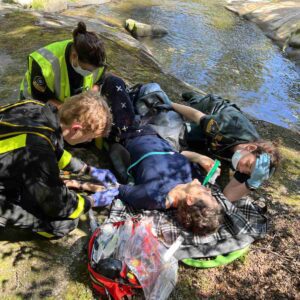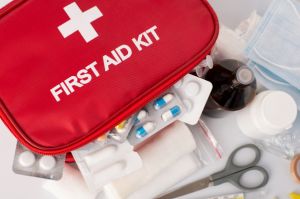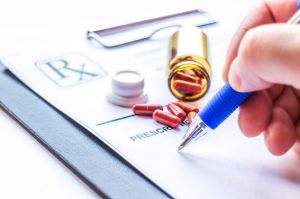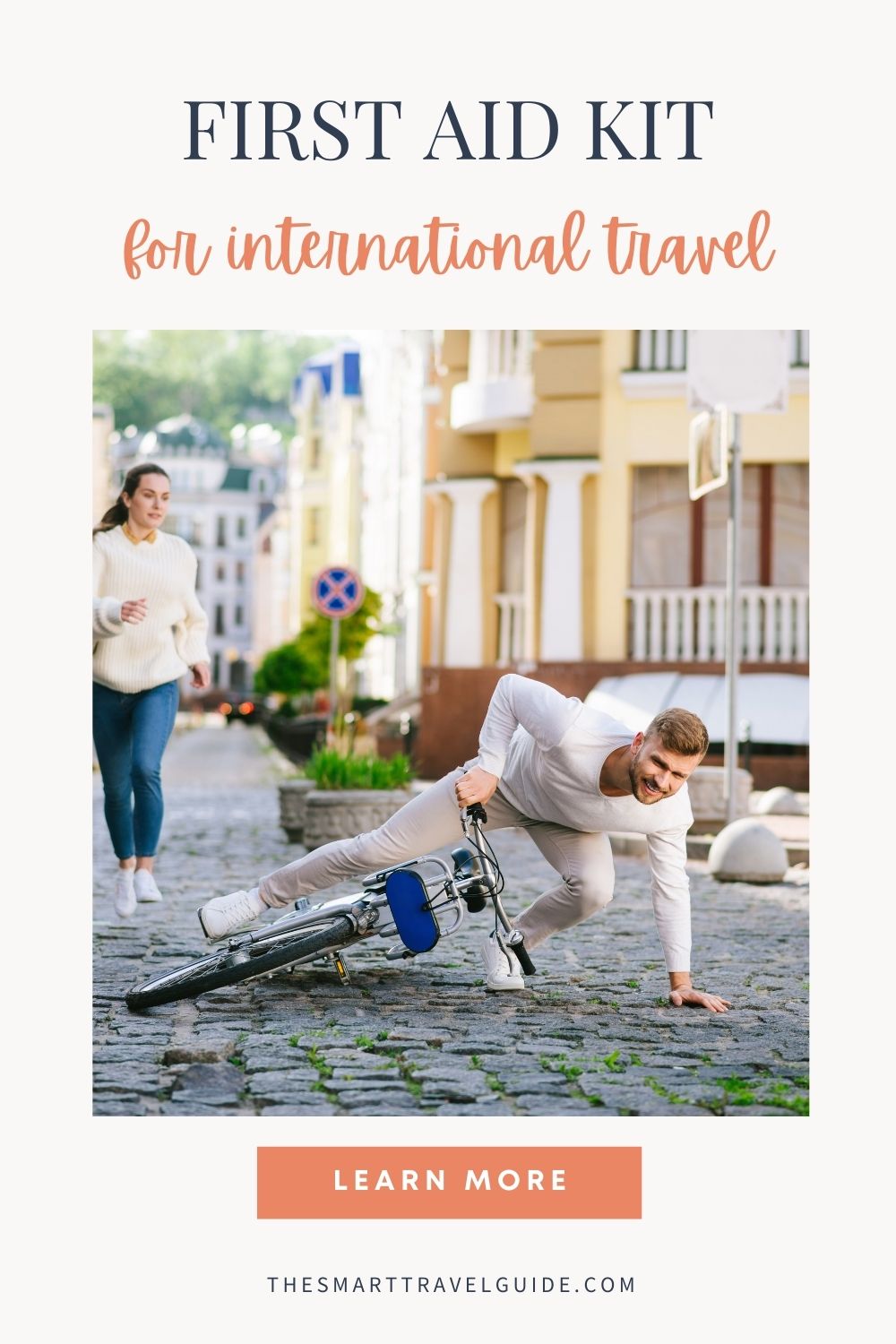READING TIME, 7 MINUTES
Finding medical care in an unfamiliar place can be challenging, especially for travelers new to the joys of international adventures or exploring remote locations. And we travelers over 50 can have some extra health care needs at times. But don't fret! This guide will help you create the best first aid kit for international travel so that you can handle medical hiccups with ease.
I’ve been traveling the world for over 30 years, and I’ve had my fair share of scrapes, sprains, emergency trips to the doctor, and nights crawling on the floor to the toilet. One memorable incident was in Cambodia, where I had to find an ophthalmologist because of a serious issue with my eye. At that time, there were only two in the entire country! The one I finally found was in a compound under armed guard.

PEGGY GOES SPLAT
And then there was the time I broke my leg while visiting New Zealand. We had been hiking for less than an hour, so Malcolm walked out and called for help. But we had planned ahead and packed a GPS unit so we could have gotten help if we were further along our trek.
Experiences like this have taught me the importance of being prepared. The idea is to think about your current health needs and what migh happen on your trip based on the activities you have planned, then create a first aid kit accordingly.
In this post, I’ll guide you through creating the best first-aid kit for international travel. Whether you’re taking your first overseas trip or are an experienced traveler heading to remote locations, this guide will help you be prepared, confident, and excited to head out.
But first, a disclaimer: I'm not a doctor, and I'm not offering medical advice. The following is general information only. It's compiled from personal experience and advice from references like the CDC and the U.S. State Department.
I suggest you create an initial list of items to include in your first aid kit, then review it with your GP or a doctor who specializes in travel medicine to get their thoughts on what else to include based on your medical history and current needs.
Supplies and Equipment in a First Aid Kit for International Travel
A well-equipped first aid kit is essential for any traveler, especially if you're going to another country. Here are some things you might want to include including:
Basic supplies
 A basic first aid kit should have adhesive bandages in various sizes, sterile gauze pads, adhesive tape, and hand sanitizer or antiseptic wipes with at least 60% alcohol. These items are crucial for treating minor cuts, scrapes, and wounds.
A basic first aid kit should have adhesive bandages in various sizes, sterile gauze pads, adhesive tape, and hand sanitizer or antiseptic wipes with at least 60% alcohol. These items are crucial for treating minor cuts, scrapes, and wounds.
If you'll be doing a lot of walking, it's a good idea to bring along Moleskin for blisters and an elastic bandage in case you sprain an ankle or knee.
Include a pair of tweezers for removing splinters and ticks, as well as a small pair of scissors for cutting tape or gauze. Don’t forget a digital thermometer to monitor fevers and a couple of pairs of disposable gloves to keep things sanitary. A few cotton swabs always come in handy.
>>> RESOURCE: TSA's guide for bringing scissors on a plane
Wear glasses or contacts? Bring a spare pair if you have time. And bring a prescription. You can often find stylish glasses for less than you'd pay in the U.S. so you can pick up a spare pair.
If you have a pre-existing condition, such as diabetes or a serious allergy, you should consider a medical alert bracelet or necklace. This is especially important if you're traveling alone without a family member or someone who knows your medical history.
Advanced supplies
For more serious issues, consider adding additional first aid supplies like an instant cold pack for sprains or bruises, a triangular bandage and safety pins to fashion a sling, and a CPR face shield for emergencies. A first-aid manual or quick reference guide can also be very helpful during stressful situations.
First aid tools
Lastly, don't overlook tools like a flashlight with extra batteries so you don't trip if you're out later than expected, a whistle in case you need to signal for help, a multi-tool that includes a knife and other useful devices, and a GPS tracker if you'll be going off-grid.
Medications to Bring When You Travel Internationally
Carrying the right medication can save you from a lot of trouble. Here are some essentials:
Prescription medicines
 Be sure you have enough prescription medications to last the entire trip, plus a few extra days’ worth in case you find an exciting adventure that extends your trip or your return home is delayed.
Be sure you have enough prescription medications to last the entire trip, plus a few extra days’ worth in case you find an exciting adventure that extends your trip or your return home is delayed.
Keep these in their original containers, clearly labeled, and bring a copy of your prescription in case you need to get an unexpected refill.
Not all brand medications are available in every country, so include the generic name on the prescription in case you need a refill and the brand isn't available.
I also suggest you update the health app on your phone. In case of an emergency, medical professionals will then be able to determine your medical conditions and the medications you're taking so they can provide proper care.
Over-the-counter medications
Pack a variety of over-the-counter medications to cover common ailments.
Pain relievers like ibuprofen or acetaminophen are a must. Bring antihistamines for allergic reactions, antacids for digestive issues, anti-diarrheal medication for unexpected stomach problems, and motion sickness medication if you're subject to that.
Toss in antifungal and antibacterial ointments to prevent infection if you get a cut or scrape, topical corticosteroids for insect bites and stings, and gel or lotion to soothe sunburns. And think about a cough suppressant or expectorant, especially if a pharmacy or chemist won't be readily available.
Specialty medications and equipment
Depending on your destination, you might need additional medications.
For instance, if you'll be traveling to a malaria-prone area, consult your doctor about anti-malarial tablets. For high-altitude destinations, ask about medications to prevent altitude sickness. And if you're traveling to remote areas where diseases are transmitted through blood, bring lancets, assorted syringes, IV cannulas, etc. Check with the CDC, then talk with your doctor.
Pack anything else you may need to manage your health, like diabetic supplies, inhalers, and EpiPens.
How to Travel Internationally with Medication and Medical Equipment
Transporting medication and medical equipment across borders can be tricky. Here’s how to do it right:
Documentation
Always carry a copy of your prescriptions and a doctor’s note explaining why you need them. This documentation will come in handy if you’re questioned by customs officials or airport security.
Packing tips
Keep all medications in your carry-on luggage to avoid losing them if your checked bags go missing.
Also, keep any other essential items you might need in your carry-on bags until you can be reunited with the rest of your medical supplies in your checked luggage, especially if you're on a long flight.
>>> RESOURCES: The TSA website has updates on what you can and can’t carry on the plane.
Rules and regulations
Research the regulations of the countries you’re visiting. Some places have strict rules about certain drugs, even ones we might be able to buy over-the-counter. A little homework can prevent big headaches.
>>> RESOURCES: Check the U.S. Department of State’s country information for the latest info on your destination country. There’s a wealth of info there.
And while you’re there, sign up for the Smart Traveler Enrollment Program if you haven’t already done so.
How to Protect Your Health While Traveling Internationally
Staying healthy while traveling is about more than just having a good first aid kit. Here’s what else you can do:
Vaccinations and preventive measures
Check the vaccination requirements and recommendations for your destination. Visit your healthcare provider well in advance to get any necessary shots. Carry a record of your vaccinations with your other travel documents. And bring masks, just in case.
>>> RESOURCES: Enter your destination on the CDC's website to see all the health-related information.
Hygiene practices
Practice good hygiene to avoid illness.
Wash your hands frequently with soap and water, or use hand sanitizer when washing isn’t an option. Be cautious with food and water! Stick to bottled water and avoid raw or undercooked foods in areas where foodborne illnesses are common. No "tourist tummy" for you!
Stay active and hydrated
Walking is a great way to see new places and keep fit. Drink plenty of water, especially in hot climates, to stay hydrated and avoid heat-related illnesses.
Where to Buy Commercial Medical Kits
If you prefer to buy a ready-made first aid kit, there are plenty of options available. You can add and subtract items as needed for each trip.
Online retailers
Websites like Amazon offer a wide range of first aid kits tailored for travelers. Look for kits that include the majority of supplies based on your needs.
Pharmacies and travel stores
Local pharmacies and travel stores often carry compact travel kits for minor injuries. These can be convenient for last-minute purchases and allow you to see the contents before buying. These are great for short trips.
Specialty stores
For high-quality, specialized kits, consider stores that focus on outdoor or travel gear. REI or Adventure Medical Kits, for example, offer kits that are designed for adventurers and include more advanced supplies.
Final Thoughts
Unexpected things can happen anywhere, right? And traveling internationally, especially for those over 50, comes with its own set of challenges. So, being prepared with the best international first aid kit for your unique needs can make all the difference in having a safe and enjoyable trip.
Be sure to review your first aid kit list with your doctor or travel medicine specialist and heed their advice so you'll stay safe and healthy.
Happy travels, and here’s to many more adventures ahead! 🌍🩹✈️
But before you go ... I've got a question for you. What is the #1 first aid item you would never travel without? Let us know in the comments below.hiking
🔆🔆🔆 Here are some other posts to help you on your next trip.
Will You Need a Visa to Go to Europe in 2025? You Might!
How to Pack Vitamins and Supplements for Travel
How to Choose the Best Travel Insurance for Your Next Trip
What Travel Documents Do You Need for an International Trip?
Did you find this post helpful?
PIN IT so others can too!


Great post! How terrifying to break your leg while in a different country! This is a good reminder to take a look at my first aid kit.
Thanks for understanding, Katie. We were hiking, too, so it was a big, exciting helicopter rescue. Thankfully, everything worked out OK.